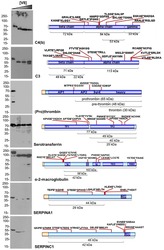Antibody data
- Antibody Data
- Antigen structure
- References [1]
- Comments [0]
- Validations
- Other assay [1]
Submit
Validation data
Reference
Comment
Report error
- Product number
- PA5-29147 - Provider product page

- Provider
- Invitrogen Antibodies
- Product name
- Complement C4b Polyclonal Antibody
- Antibody type
- Polyclonal
- Antigen
- Synthetic peptide
- Description
- Recommended positive controls: human plasma. Store product as a concentrated solution. Centrifuge briefly prior to opening the vial.
- Reactivity
- Human
- Host
- Rabbit
- Isotype
- IgG
- Vial size
- 100 µL
- Concentration
- 1 mg/mL
- Storage
- Store at 4°C short term. For long term storage, store at -20°C, avoiding freeze/thaw cycles.
Submitted references Insight into the human pathodegradome of the V8 protease from Staphylococcus aureus.
Frey AM, Chaput D, Shaw LN
Cell reports 2021 Apr 6;35(1):108930
Cell reports 2021 Apr 6;35(1):108930
No comments: Submit comment
Supportive validation
- Submitted by
- Invitrogen Antibodies (provider)
- Main image

- Experimental details
- Figure 4. Validation of V8 serum substrates identified by N-terminomics Serum was treated with varying concentrations of V8. Linear schematics depict the primary structure of proteins, with domains from UniProt/UniRef indicated. Cleavage sites inferred by N-terminomics are indicated by red markers, the scissile bond/V8 cleavage site is indicated by an asterisk with surrounding residues shown. Fragments and their ~predicted mass (calculated using ProtParam), with degradation products visible in corresponding western blots, are shown on schematics for serotransferrin, alpha-2-macroglobulin, SERPINA1, and SERPINC1. Prothrombin produced no visible degradation products; instead, the intact form and native products (produced by proteolytic activation) are depicted and visible in the untreated serum blot. AP1, activation peptide fragment 1; AP2, activation peptide fragment 2; light, thrombin light chain; heavy, thrombin heavy chain; TF1, Transferrin-like domain 1; TF2, transferrin-like domain 2; Ig, Ig-like fold; BR, bait region; RBD, receptor binding domain; RCL, reactive center loop. See also Figure S4 .
 Explore
Explore Validate
Validate Learn
Learn Western blot
Western blot Other assay
Other assay